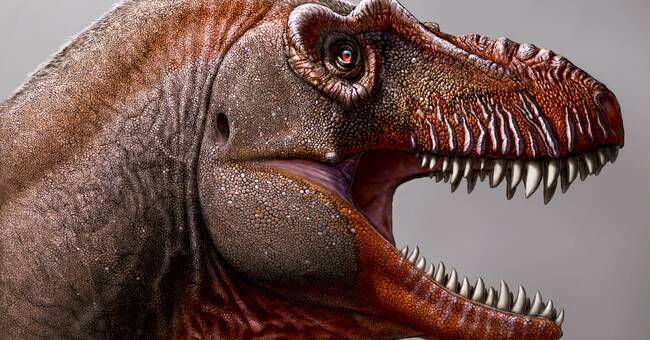Tyrannosaurus rex, commonly called the king of dinosaurs, has a new relative.
It was the farmer and paleontologist, John De Groot, who found the fossil during a hike near the Hays in Alberta.
- The jaw is an absolutely fantastic find.
We knew it was special because you could see the fossilized teeth clearly, De Groot told CNN.
Named after the Greek god of death
The name of the new relative is Thanatotheristes degrootorum;
Thanatos is the Greek god of death and theristes means the one who reaps.
The dinosaur got its surname from its discoverer, De Groot.
Several fossils have been found in Canada, especially in Alberta, over the years, but the fossil now found is the first new Tyrannosauri in Canada in 50 years.
And also one of the oldest species found in North America.
Vivi Vajda at the Swedish Museum of Natural History believes that the find is unusual.
- It is a very exciting find, that it is about a top predator, a predator, there may not have been so many of them in the ecosystem.
It shows another branch on the family tree for these large dinosaurs, says Vivi Vajda professor of paleontology at the Swedish Museum of Natural History in Stockholm.
Scientists believe that Thanatotheristes degrootorum lived about 2.5 million years before its closest relative, Tyrannosaurus rex, and according to information known so far, it can reach a length of around nine meters and weighed more than two tons as an adult.
The T-rex could be about 12 meters.
- Even though it was smaller than the Tyrannosaurus Rex, it may have played a very important role in the ecosystem.
It also shows that there was a great wealth of species during that time, says Vivi Vajda.
Different from the T-rex
By identifying unique parts of the fossil, the researchers were able to determine that it was a different species than the already known Tyrannosaurus rex.
"Thanatotheristes differ from other Tyrannosaurs in several unique properties of the skull, but the most prominent are vertical vertebrae that run along the upper jaw," says Jared Voris, research leader and doctoral student at the University of Calgary.
An important piece of the puzzle for the researchers
The discovery has also enabled researchers to determine that different groups of Tyrannosaurs lived apart over North America during the later Cretaceous, between 74 and 80 million years ago.
The group to which Thanatotheristes belongs lived between southern Alberta and Montana, while other groups may have been found in central Alberta or in the southern parts of the United States.
The discovery of Thanatotheristes shows the diversity, not only of Canada's fossil finds, but also of the Tyrannosaur family.
- The discovery is important because it fills a gap in our understanding of Tyrannosaur evolution, says Dr. François Therrien, curator of dinosaur palaeoecology at the Royal Tyrrell Museum.

